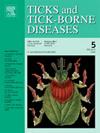Environmental factors determining the survival of winter ticks (Dermacentor albipictus) at different life stages in Québec, Canada
IF 3.4
2区 医学
Q2 INFECTIOUS DISEASES
引用次数: 0
Abstract
Ticks are responsible for large economic losses because of their impact on livestock and wildlife. In recent years, winter ticks (Dermacentor albipictus) have caused mass mortalities in moose (alces) populations of North America, leading to host mortality due to severe blood loss. During their off-host stages (i.e. egg and larvae), winter ticks are particularly vulnerable to mortality because of potential exposure to stressful abiotic conditions that could dehydrate eggs or freeze larvae. We conducted a field experiment in Québec, Canada, to better understand larval questing behaviour and assess the ability of unfed larvae to survive over the winter to the following fall. In the laboratory, we tested the tolerance of eggs to different saturation deficits reflected by combinations of temperature and humidity and evaluated the tolerance of larvae to sub-freezing temperatures. We found that unfed winter tick larvae did not survive until a second fall regardless of habitat types (open, closed or sheltered from the snow) and thus could not quest for a host for two consecutive years. However, unfed larvae withstood short-term exposure to low sub-freezing temperatures, potentially prolonging their questing period and increasing the likelihood of moose infestations. Egg survival varied among saturation deficits, but survival tended to be higher at 30 °C and lower at 22 °C regardless of the saturation deficit. Overall, we found that the free stages of winter ticks are highly tolerant of extreme conditions, reinforcing the concern that winter ticks represent for moose populations.
环境因素对加拿大魁省冬蜱(白纹革蜱)不同生命阶段生存的影响
蜱虫对牲畜和野生动物的影响造成了巨大的经济损失。近年来,冬季蜱虫(白纹革螨)在北美驼鹿(alces)种群中造成了大量死亡,导致宿主因严重失血而死亡。在它们的离宿主阶段(即卵和幼虫),冬季蜱特别容易死亡,因为它们潜在地暴露在可能使卵脱水或冻结幼虫的紧张的非生物条件下。为了更好地了解幼虫的觅食行为,并评估未喂食的幼虫在冬季至次年秋季的生存能力,我们在加拿大的quacimbec进行了一项野外实验。在实验室中,我们测试了卵对温度和湿度组合反映的不同饱和缺陷的耐受性,并评估了幼虫对亚冰点温度的耐受性。我们发现,无论栖息地类型(开放、封闭或避雪)如何,未被喂食的冬季蜱虫幼虫都不能存活到第二次秋天,因此连续两年无法寻找宿主。然而,未被喂食的幼鹿能够承受短期的低于冰点的低温,这可能会延长它们的觅食时间,增加驼鹿侵扰的可能性。卵子存活率因饱和不足而异,但无论饱和不足程度如何,在30°C时存活率较高,在22°C时存活率较低。总的来说,我们发现冬季蜱虫的自由阶段对极端条件具有高度的耐受性,这加强了人们对冬季蜱虫代表驼鹿种群的关注。
本文章由计算机程序翻译,如有差异,请以英文原文为准。
求助全文
约1分钟内获得全文
求助全文
来源期刊

Ticks and Tick-borne Diseases
INFECTIOUS DISEASES-MICROBIOLOGY
CiteScore
6.90
自引率
12.50%
发文量
185
审稿时长
6-12 weeks
期刊介绍:
Ticks and Tick-borne Diseases is an international, peer-reviewed scientific journal. It publishes original research papers, short communications, state-of-the-art mini-reviews, letters to the editor, clinical-case studies, announcements of pertinent international meetings, and editorials.
The journal covers a broad spectrum and brings together various disciplines, for example, zoology, microbiology, molecular biology, genetics, mathematical modelling, veterinary and human medicine. Multidisciplinary approaches and the use of conventional and novel methods/methodologies (in the field and in the laboratory) are crucial for deeper understanding of the natural processes and human behaviour/activities that result in human or animal diseases and in economic effects of ticks and tick-borne pathogens. Such understanding is essential for management of tick populations and tick-borne diseases in an effective and environmentally acceptable manner.
 求助内容:
求助内容: 应助结果提醒方式:
应助结果提醒方式:


